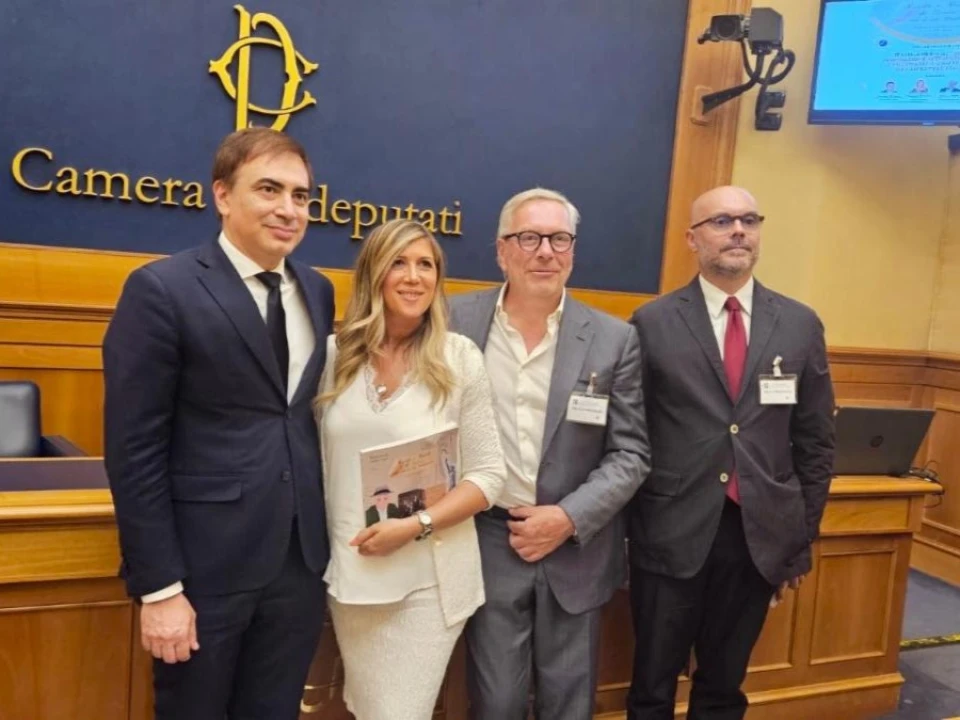In the institutional setting of the Italian Chamber of Deputies, a socio-cultural talk compared the old and new waves of Italian immigration to America, unveiling the challenges and achievements of generations of emigrants.
The event was inspired by the presentation of the book "Recipes and Memories of Grandpa – A Mediterranean Lifestyle," a work that recounts the extraordinary life of Angelo Iovine, who lived to the age of 102.
Born in the small town of Mariglianella, in the Naples hinterland, Angelo arrived at New York's Ellis Island immigration control center at just 17, bringing with him not only dreams and determination but also a mental recipe book of simple, humble dishes adapted to the ingredients available in the new land, the land of the American dream.
The book, co-written by Ashley Carr and Frank Iovine, Angelo's grandson, and translated by journalist Francesca Di Matteo, is more than just a cookbook; it is an emotional journey through culinary traditions and the Mediterranean lifestyle that Angelo kept alive throughout his long journey. The recipes, passed down orally, are testimonies of resilience and adaptation, and represent a cultural bridge between Italy and the United States. "Every dish tells a story of love for nature and cultural identity," emphasized Francesca Di Matteo during the presentation, adding that the book, published by Graus Edizioni in a bilingual format, aims to highlight the dual identity of emigrants in America and around the world.
The initiative enthusiastically embraced by Deputy Christian Di Sanzo, who welcomed the attendees at Montecitorio and highlighted the importance of the stories of Italians abroad, provided an opportunity to reflect on how Italian immigration has evolved. With the intervention of university professor Stefano Pelaggi, an expert in Italians around the world and the role of cuisine as an integral part of settling into a host society, a comprehensive overview of the history of immigration to America was presented.
At the beginning of the 20th century, many emigrants were poor, mostly illiterate individuals seeking economic opportunities. Today, the new generations bring skills and professionalism, strengthening the bond between Italy and America and contributing to the spread of Made in Italy. This bond, born from the migratory flow at the beginning of the 1900s between Italy and the land of opportunities, America, faced a society that was hostile, racist, and discriminatory, often labeling Italians as "spaghetti eaters" and "uncouth, dirty, illiterate people." This massive migration underwent strict inspections by national services both upon arrival at Ellis Island and later in their homes, where, as described by Professor Pelaggi, "pantries were opened and coffee, wine, pasta, and all those products deemed unsuitable by American society, which focused on protein consumption and prohibited alcohol, were confiscated. Hence, the Mediterranean diet was seen as negative."
Many cases of children and teenagers were removed from their families due to Mediterranean customs where giving a fifteen-year-old boy a little wine on Sundays was part of their cultural background. Despite all these battles, these migrants, whom Pelaggi noted were primarily from Genoa, Piedmont, Naples, and Calabria, managed not only to maintain their culinary and cultural traditions but also to crystallize, at some point, within American society and cuisine. Unlike other emigrants, such as Germans, Irish, and Spaniards, who quickly abandoned their traditions, Italians were the only ones to keep them strong.
The moment of crystallization, or acceptance, by American society regarding Italian food is particularly interesting. What was once "forbidden" became "exotic" cuisine. With a photo from a 1950s Vogue article, journalist Di Matteo showed the many attendees in Montecitorio's press room how there was a genuine education about Italian food in America. A model demonstrated how to eat spaghetti, how to twirl them around a spoon—a practice that is no longer common in Italy but was once customary—until they could savor it as new, innovative, and exotic food. Certainly, adaptation was inevitable. This change is evident in the cuisine, where "hybrid" dishes like chicken parmigiana and spaghetti with meatballs, though inspired by tradition, adapted to the tastes and ingredients available in America, and the opportunity to finally eat meat, which was scarce among the poor in Italy.
The book's presentation highlighted how the stories of emigrants from yesterday and today are linked by a red thread of courage, adaptation, and love for their roots. Angelo Iovine, with his mental recipe book and Mediterranean lifestyle, represents not only a historical figure but also a symbol of resilience and hope for the new generations of Italians abroad. In an era when the Mediterranean diet is recognized as UNESCO heritage, Angelo's story reminds us of the importance of living in harmony with ourselves and others, keeping traditions alive. The project is supported not only by Italian-Americans but also by the new generation of Italians in America who strengthen this transatlantic bond every day. Import-export companies, ensuring maximum distribution of Italian products in America; professionals specializing in resolving the bureaucratic hurdles of Italian brands in America; yacht management companies arriving in Italy; and restaurant professionals, the first to promote Italian cuisine as intangible heritage between sustainability and biocultural diversity, for which Italy is a candidate for UNESCO 2025. Italian language experts who daily spread and promote the language of the Belpaese in America after years of being banned within families. If in the past Italian immigrants struggled not to speak Italian at home, and if they did, it was in dialect, today Italian-Americans feel the need to reclaim a language that is part of their childhood and, above all, of their cultural and historical identity and heritage. The bond between Italy and America grows stronger.



